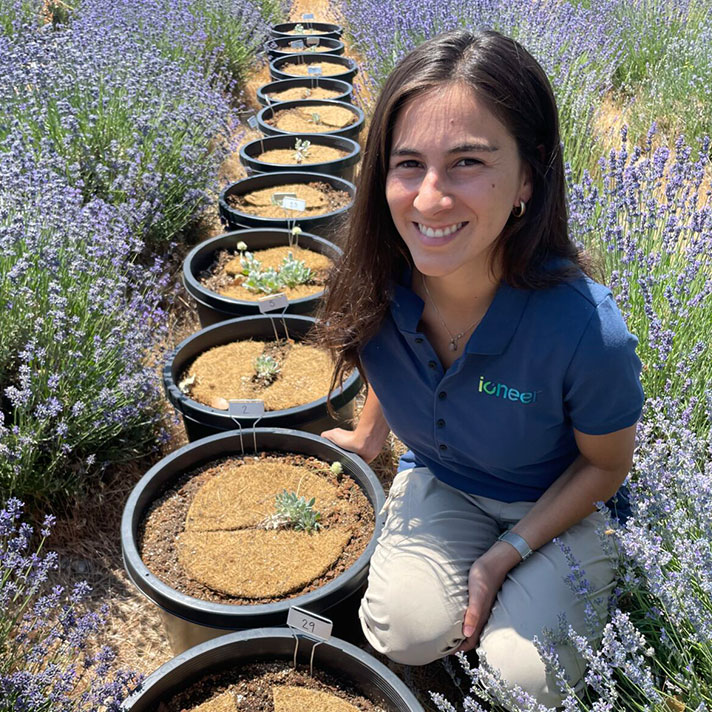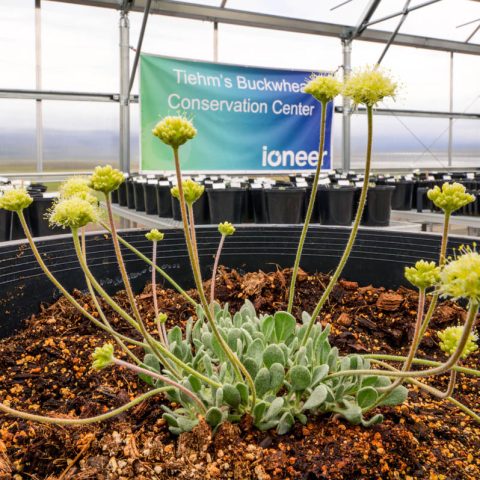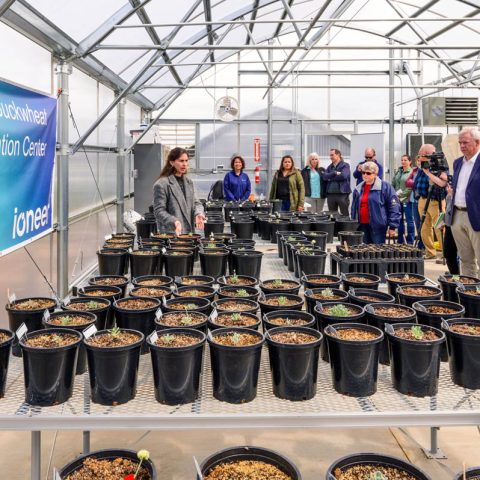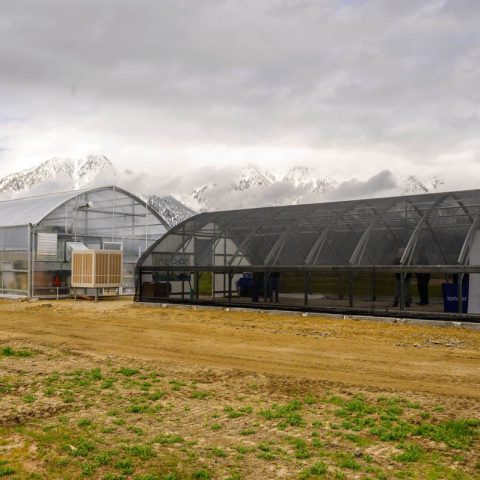Tiehm’s Buckwheat Conservation
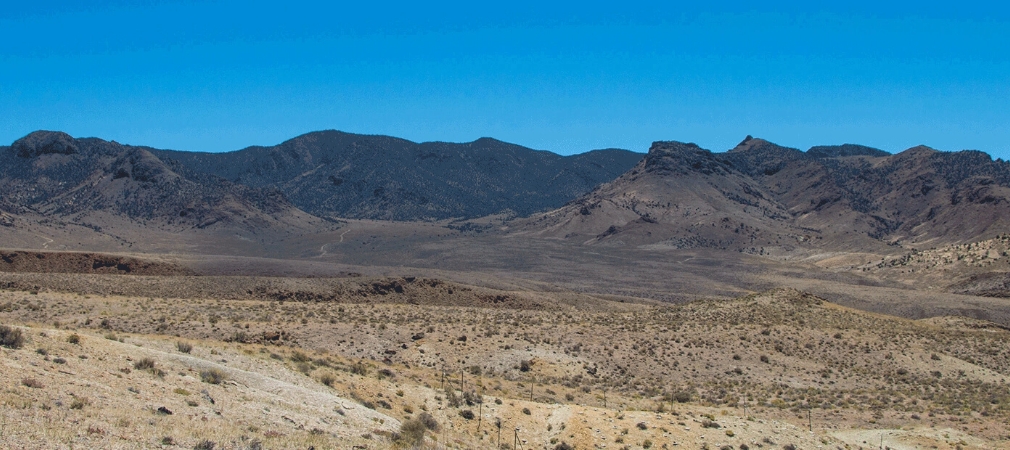
About Tiehm’s buckwheat
Tiehm’s buckwheat (Eriogonum tiehmii) is a low-growing perennial herb, first identified in Esmeralda County, Nevada, in 1983. In December 2022, the U.S. Fish and Wildlife Service (FWS) listed Tiehm’s buckwheat under the Endangered Species Act and designated 910 acres of critical habitat to help conserve the plant.
To ensure the long-term viability of Tiehm’s buckwheat within and near Rhyolite Ridge, we have evaluated a broad range of protection and management measures to maintain and uplift the species. In developing these options, Ioneer consulted with experts who have studied other buckwheat species in Nevada, and who are familiar with similar conservation plans in the Western U.S.
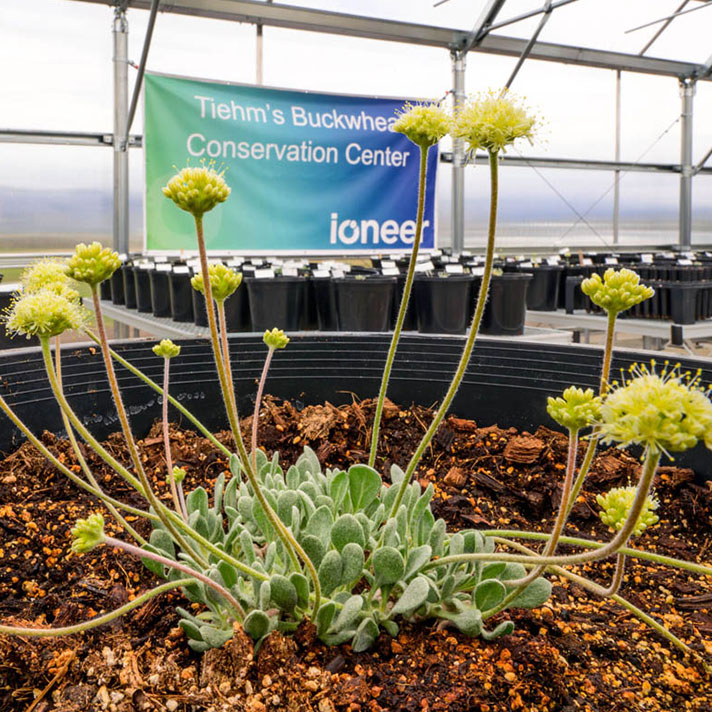
Tiehm’s buckwheat at Ioneer’s Conservation Center in May 2023.
How Ioneer is protecting Tiehm’s buckwheat
Ioneer is committed to Tiehm’s buckwheat conservation while sustainably developing our Rhyolite Ridge Project, which will add a critical supply of lithium and boron to the U.S. electric vehicle supply chain and reduce greenhouse gas emissions.
Ioneer actively supported the U.S. Fish and Wildlife Services’ endangered species classification in December 2022. But prior to the federal designation, Ioneer had already invested $1.5 million in Tiehm’s buckwheat conservation. We have taken significant voluntary measures to ensure the plant and its habitat are protected, including installing fencing and signage around sensitive areas, conducting a full survey of the existing buckwheat population prior to any field activities, and developing and implementing a Bureau of Land Management (BLM)-approved protection plan. We have also constructed a dedicated greenhouse to grow Tiehm’s buckwheat and hired a full-time botanist, who is working to propagate and transplant seeds, a process called translocation, to Rhyolite Ridge. Once this is complete, Ioneer will tend to the plant’s continued recovery.
Ioneer has dedicated an additional $1 million annually for the plant’s continued protection. In May 2023, we opened a greenhouse dedicated solely to researching and conserving native Nevada species, and shared positive results in growing the plant in new soil conditions using from seeds safely collected from the known populations. We also hired two botanical experts to develop protection measures that will ensure the plant can thrive in natural conditions, including the extremes posed by climate change.
In developing these options, Ioneer consulted with experts who have studied other buckwheat species in Nevada, and who are familiar with similar conservation plans in the Western U.S.
Specifically, we worked in the following ways to protect and conserve this sensitive species in its natural habitat:

Establishing a Protection Plan
Ioneer has developed and implemented a BLM approved comprehensive Tiehm’s Buckwheat Protection Plan that includes strict measures that have been in place since Ioneer commenced exploration at Rhyolite Ridge in 2016. The goal of these voluntary measures is to ensure that the plant and its habitat are protected, and that the potential impacts caused by development of the Project are minimized.
A central component of the Buckwheat Protection Plan involves complete avoidance of all populations of Tiehm’s buckwheat, with a buffer zone between all mining activities and the plants. In the meantime, Ioneer is committed to increasing the area of the buckwheat population.
Working with regulators
The protection and conservation of Tiehm’s buckwheat is a key component in Ioneer’s environmental stewardship and incorporated into all aspects of our planning and permitting activities.
In July 2022, the Company submitted to the U.S. Bureau of Land Management (BLM) a revised Plan of Operations that incorporated additional key commitments relating to buckwheat conservation:
- Minimizing and mitigating indirect impacts utilizing standard operating measures; and
- Minimizing disturbance within designated critical habitat.
Ioneer’s ongoing conservation efforts for Tiehm’s buckwheat are aimed at addressing current and future threats to the species, including climate-related threats.
Under the supervision of a full-time botanist, the Company is conducting scientific research to further increase knowledge of the species and is now operating a dedicated greenhouse in Nevada where plants are being successfully grown from seed collected from the known populations.
Developing a Conservation Plan
Ioneer has budgeted $1 million over each of the next several years to conduct research and implement conservation measures to address existing risks to Tiehm’s buckwheat, and to uplift and expand the species.
In May 2023, Ioneer opened its dedicated greenhouse in Nevada to grow Tiehm’s buckwheat from seeds collected at Rhyolite Ridge.
In June 2022, we hired a full-time botanist who oversees the greenhouse and growing of the plant. Our greenhouse activities will help to guide and inform future propagation and transplant studies as we seek to support the Tiehm’s buckwheat population.
Minimizing potential impacts
Ioneer first instituted strict protective measures when we began exploration in 2016, prior to any field activities. We have conducted all work in consultation with regulatory authorities and guidelines and have taken great care to avoid the buckwheat subpopulations.
These efforts included modifying locations of boreholes to avoid the plants, drilling boreholes in several directions from a common drill pad to reduce the total amount of surface disturbance, educating employees and contractors about the plant, and other avoidance measures.
Ioneer will use Fugitive Dust Best Management Practices to ensure that there is no dust within any of the subpopulations.
As appropriate, additional targeted control efforts to limit the spread of invasive plant species and treat infestations will be employed utilizing best practices.
Engaging buckwheat specialists
Ioneer has retained the services of academic and commercial experts to enhance our science-driven approach and develop protection measures that will ensure the plant thrives in its natural habitat. Our specialists are members of the Eriogonum Society, a professional association whose members have expertise in evaluating, propagating, and protecting various types of buckwheat.
Ioneer is working with The Conservation Fund to further explore viable options around protection and conservation efforts for Tiehm’s buckwheat. The Conservation Fund is one of the largest non-profit environmental groups in the United States and has worked with relevant federal agencies on buckwheat conservation strategies.
Enhancing knowledge with research
Ioneer worked with researchers at the University of Nevada, Reno (UNR) over thirteen months to conduct a propagation and transplant trial for Tiehm’s buckwheat. The project successfully grew over 1,000 Tiehm’s buckwheat seedlings in the UNR greenhouse from seeds collected at Rhyolite Ridge. These seedlings were planted in three test sites in the Project Area in April 2020.
Ioneer has expanded the scope of its work with commercial research partners alongside continued collaboration with academic researchers to determine the best ways to uplift the species.
Committed to Tiehm’s buckwheat conservation
Ioneer remains committed to pursuing conservation efforts for Buckwheat which address current gaps in our scientific knowledge of the species and to address threats that are unrelated to our proposed mining activities.
We have completed numerous studies and greatly advanced scientific knowledge of the plant. This work has resulted in several new clarifications from previous studies.
Ioneer will continue its cooperative work with the relevant agencies on these efforts. Examples of the potential work developed with the BLM and the FWS include, but may not be limited to:
- Field surveys for new populations
- Seed collection and banking
- Herbivory monitoring
- Pollinator studies
- Seeding studies
- Ecological studies to understand the factors determining the distribution of buckwheat
- Propagation and transplant studies
- Demographic Monitoring
- Population modeling
- Climate monitoring
- Genetic analyses
Informed by the best available science, we are highly confident that with a combination of avoidance and mitigation efforts, we can achieve the successful coexistence of Tiehm’s buckwheat and our environmentally important project.
